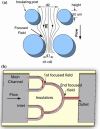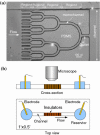Rapid Concentration of Nanoparticles with DC Dielectrophoresis in Focused Electric Fields
- PMID: 20652137
- PMCID: PMC2893963
- DOI: 10.1007/s11671-009-9442-3
Rapid Concentration of Nanoparticles with DC Dielectrophoresis in Focused Electric Fields
Abstract
We report a microfluidic device for rapid and efficient concentration of micro/nanoparticles with direct current dielectrophoresis (DC DEP). The concentrator is composed of a series of microchannels constructed with PDMS-insulating microstructures for efficiently focusing the electric field in the flow direction to provide high field strength and gradient. The location of the trapped and concentrated particles depends on the strength of the electric field applied. Both 'streaming DEP' and 'trapping DEP' simultaneously take place within the concentrator at different regions. The former occurs upstream and is responsible for continuous transport of the particles, whereas the latter occurs downstream and rapidly traps the particles delivered from upstream. The performance of the device is demonstrated by successfully concentrating fluorescent nanoparticles. The described microfluidic concentrator can be implemented in applications where rapid concentration of targets is needed such as concentrating cells for sample preparation and concentrating molecular biomarkers for detection.
Keywords: DC dielectrophoresis; Electrokinetics; Microfluidics; Nanoparticles.
Figures





Similar articles
-
Dielectrophoresis in microchips containing arrays of insulating posts: theoretical and experimental results.Anal Chem. 2003 Sep 15;75(18):4724-31. doi: 10.1021/ac0340612. Anal Chem. 2003. PMID: 14674447
-
Particle trapping in electrically driven insulator-based microfluidics: Dielectrophoresis and induced-charge electrokinetics.Electrophoresis. 2021 Dec;42(23):2445-2464. doi: 10.1002/elps.202100123. Epub 2021 Jun 15. Electrophoresis. 2021. PMID: 34081787 Free PMC article. Review.
-
An insulator-based (electrodeless) dielectrophoretic concentrator for microbes in water.J Microbiol Methods. 2005 Sep;62(3):317-26. doi: 10.1016/j.mimet.2005.04.027. J Microbiol Methods. 2005. PMID: 15941604
-
Continuous-Flow Nanoparticle Trapping Driven by Hybrid Electrokinetics in Microfluidics.Electrophoresis. 2021 Apr;42(7-8):939-949. doi: 10.1002/elps.202000110. Epub 2020 Aug 7. Electrophoresis. 2021. PMID: 32705697
-
Dielectrophoresis for manipulation of micro/nano particles in microfluidic systems.Anal Bioanal Chem. 2010 Jan;396(1):401-20. doi: 10.1007/s00216-009-2922-6. Epub 2009 Jul 4. Anal Bioanal Chem. 2010. PMID: 19578834 Review.
Cited by
-
Dielectrophoresis for bioparticle manipulation.Int J Mol Sci. 2014 Oct 10;15(10):18281-309. doi: 10.3390/ijms151018281. Int J Mol Sci. 2014. PMID: 25310652 Free PMC article. Review.
-
Joule heating-induced particle manipulation on a microfluidic chip.Biomicrofluidics. 2019 Feb 22;13(1):014113. doi: 10.1063/1.5082978. eCollection 2019 Jan. Biomicrofluidics. 2019. PMID: 30867883 Free PMC article.
-
Simple and reusable picoinjector for liquid delivery via nanofluidics approach.Nanoscale Res Lett. 2014 Mar 25;9(1):147. doi: 10.1186/1556-276X-9-147. Nanoscale Res Lett. 2014. PMID: 24666418 Free PMC article.
-
Rapid identification of bacteria utilizing amplified dielectrophoretic force-assisted nanoparticle-induced surface-enhanced Raman spectroscopy.Nanoscale Res Lett. 2014 Jun 27;9(1):324. doi: 10.1186/1556-276X-9-324. eCollection 2014. Nanoscale Res Lett. 2014. PMID: 25024685 Free PMC article.
-
Rapid Prototyping of a Nanoparticle Concentrator Using a Hydrogel Molding Method.Polymers (Basel). 2021 Mar 29;13(7):1069. doi: 10.3390/polym13071069. Polymers (Basel). 2021. PMID: 33805297 Free PMC article.
References
-
- Greenberg AE, Clesceri LS, Eaton AD, editor. Standard Methods for the Examination of Water and Wastewater. American Public Health Association, American Water Works Association and water Environment Federation, USA; 2005.
-
- Chen DF, Du H, Li WH. A 3D paired microelectrode array for accumulation and separation of microparticles. J. 2006;16:1162–1169. doi: 10.1088/0960-1317/16/7/008. COI number [1:CAS:528:DC%2BD28XptVKhur4%3D]; Bibcode number [2006JMiMi..16.1162C] - DOI
LinkOut - more resources
Full Text Sources

